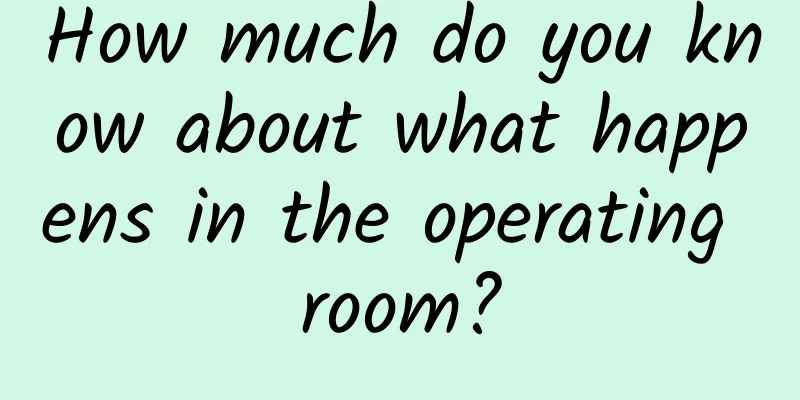What to do if gout attacks acutely? Teach you how to deal with it urgently

|
Gout is divided into acute attack phase and remission phase. Acute attacks of gout are usually accompanied by severe pain, such as severe redness, swelling and pain in the toes, ankles and other common parts. Patients often "wake up in pain in the middle of the night" or "wake up with pain and limp". Although acute attacks of gout usually subside naturally within 1 to 2 weeks, the "Guidelines of the American Association of Rheumatology (2020 Edition)" and "Guidelines of the European League Against Rheumatism (2021 Edition)" still recommend early treatment to accelerate the resolution of symptoms. 1. Symptoms of acute gout The symptoms of acute gout are often manifested as redness, swelling, heat and pain in the joints. When an attack occurs, pain usually occurs in the first toe joint of the big toe, that is, the connection between the big toe and the sole of the foot. However, it may also occur in other bone parts or joints, such as the ankle joint, instep, knee joint, elbow joint, wrist joint, finger joint, etc. This is mainly due to poor blood circulation at the extremities, and monosodium urate is easily deposited at the extremities. In addition, acute gout attacks may be accompanied by headaches and fever. The goal of treatment during an acute attack of gout is to quickly and safely relieve pain and joint disability, i.e., analgesia. Drug therapy and some accompanying non-drug treatments provide conditions for the emergency treatment of acute gout attacks. 2. Drug treatment of gout The treatment of acute gout attacks is mainly based on the patient's age and complications. The earlier the medication is used, the better the effect. It is beneficial to quickly relieve local swelling and pain in the joints. The dosage can be gradually reduced after the symptoms are relieved. 1. Patients with mild to moderate pain For patients with mild to moderate pain, the following single drugs can be used for treatment. (1) Colchicine: Use within 12 to 36 hours after the onset of the disease, take 1 to 1.2 mg orally, and then take 0.5 to 0.6 mg orally 1 hour later. (2) Oral nonsteroidal anti-inflammatory drugs: Available drugs include naproxen, indomethacin and sulindac. (3) Corticosteroids Potential steroids: Prednisone ≥ 0.5 mg/(kg·d) orally for 5-10 days without dose reduction; prednisone ≥ 0.5 mg/(kg·d) orally for 2-5 days, then gradually reduce the dose for 7-10 days, and then stop the drug; prednisolone 30-35 mg/d orally for 3-5 days. It should be noted that for elderly patients, colchicine and nonsteroidal anti-inflammatory drugs should be used with caution or not at all. Low-dose hormone therapy can be selected. When local large joints are affected, glucocorticoids can also be injected into the joint cavity to reduce swelling and relieve pain. If a patient with renal insufficiency suffers from a gout attack, he or she can be treated with short-term use of hormones such as prednisone. If the pain is relieved, drugs such as febuxostat can be used to control uric acid and reduce the attack of gout in patients with renal insufficiency. 2. Patients with severe pain Patients with severe pain, particularly when gout is acutely polyarticular or involves multiple large joints, may consider the following combination therapy options. (1) Colchicine combined with an oral nonsteroidal anti-inflammatory drug. (2) Full-dose oral corticosteroids combined with colchicine. (3) Intra-articular corticosteroid injection combined with any other treatment. If you want to relieve symptoms during an acute attack of gout, you can also take non-drug treatments. In the absence of severe heart failure or renal failure, you can drink 2000~2500 ml of water every day, which is beneficial for acute gout attacks and prevention of gout attacks. During an acute attack of gout, you should absolutely stay in bed and raise the affected limb (the limb with swollen and painful joints). Do not apply hot compresses or massage locally to prevent the pain from worsening. You can apply cold and wet compresses to the affected area. The effect is best when the skin temperature is 8~15 ℃, and the cold compress time should not be too long. Source: Quankeyuan |
<<: Weekly Science | Eye Health Tips
Recommend
What foods are good for breasts?
Healthy and full breasts can not only make women ...
How is cervical screening performed?
Cervical cancer is a malignant tumor that poses a...
Bleeding in the fifth week of pregnancy
Many mothers experience various symptoms during p...
How often is good for couples to have sex? One look and you'll know
Many couples are very concerned about the frequen...
What to do if the fetus is lying prone during 4D color Doppler ultrasound
One of the more important tests in a fetal examin...
What should I do if I catch a cold and cough during the confinement period?
Colds and fevers are now considered to be very co...
Endometrial wall thickness
If a woman has a thick endometrial wall, it will ...
Pregnancy after angiography of fimbriae adhesions
When the fallopian tubes on both sides are affect...
The Secret Behind Anesthesia: A Miraculous Journey into a Pain-Free World
Anesthesia, you may not be unfamiliar with this w...
What to do if you get pregnant with cervical erosion? Experts introduce methods!
Many women do not pay much attention to personal ...
What are the symptoms of yeast infection in women?
Fungal infection is a relatively common form of i...
Pain between breasts in women
Pain in the bone between a woman's breasts is...
What are the harms of smoking to women?
Nowadays, many women think smoking is a fashion, ...
Is it okay for women to shave their body hair?
Normal female pubic hair is related to every woma...
Menstruation comes two days early
Generally speaking, menstruation two days early w...









